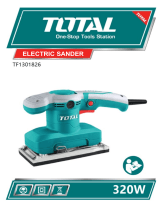
Positec Australia Pty Limited
Unit 15, 23 Narabang Way, Belrose 2085 NSW Australia
www.jcb-tools.com
Customer Helpline 1300 889 028
Our goods come with guarantees that cannot be
excluded under the Australian Consumer Law.
You are entitled to a replacement or refund for
a major failure and for compensation for any
other reasonably foreseeable loss or damage.
You are also entitled to have the goods repaired
or replaced if the goods fail to be of acceptable
quality and the failure does not amount to a
major failure. To obtain compensation, you
would need to provide documentary evidence of
the loss or damage suffered, and documentary
evidence that such loss or damage was a
reasonably foreseeable consequence of a failure
by us to comply with a consumer guarantee
under the Australian Consumer Law. Such
evidence may include photographs, statutory
declarations, receipts or reports (e.g. from your
doctor), depending on the loss or damage.
In addition to any rights and remedies you
may have under the Australian Consumer Law
and any other applicable law, if your JCB tool
becomes defective due to faulty materials or
workmanship within a period of 3 year from the
date of purchase, we guarantee to:
• Replace or repair all defective parts, free of
charge; or
• Repair products free of charge; or
• Replace the unit with a new or re-conditioned
unit free of charge.
Your warranty is subject to the following
conditions:
• Battery packs are guaranteed for a 12 month
period only.
• The tool has not been misused, abused,
neglected, altered, modified or repaired by
anyone other than an authorized service centre.
• Only genuine JCB parts that fall under normal
customer maintenance in accordance with the
instruction manual have been used on or with
the product.
• The tool has been subjected to fair wear and
tear.
• The tool has not been used for trade or
professional purposes.
• The tool has not been used for rental purposes.
• The tool has not sustained damage through
foreign objects, substances or accidents.
Your warranty does not cover:
• Components that are subject to natural wear
and tear caused by use in accordance with
operating instructions.
• Unauthorized/improper maintenance/
handling or overload are excluded from this
warranty as are accessories such as bulbs,
blades and bits, etc.
• Accessories supplied with the tool.
For claims under this JCB warranty, please
contact the JCB Helpline. To make a claim you
will need to provide proof of purchase in the form
of a valid receipt that displays the date and place
of purchase. Any expense you incur in claiming
under the JCB warranty will be borne by you.
Helpline 1300 889 028
This guarantee statement does not replace but is
in addition to your statutory rights.
This warranty applies only to the original
purchaser and may not be transferred.
All repairs and replacement tools will be
covered by the limited warranty of the balance
of the warranty period from the date of the
original purchase.
This
JCB
warranty is provided by Positec
Australia Pty Limited ACN 101 682 357 of 25
Research Drive, Croydon South VIC 3136
Address for the return of the products: The
Point of Purchase
















